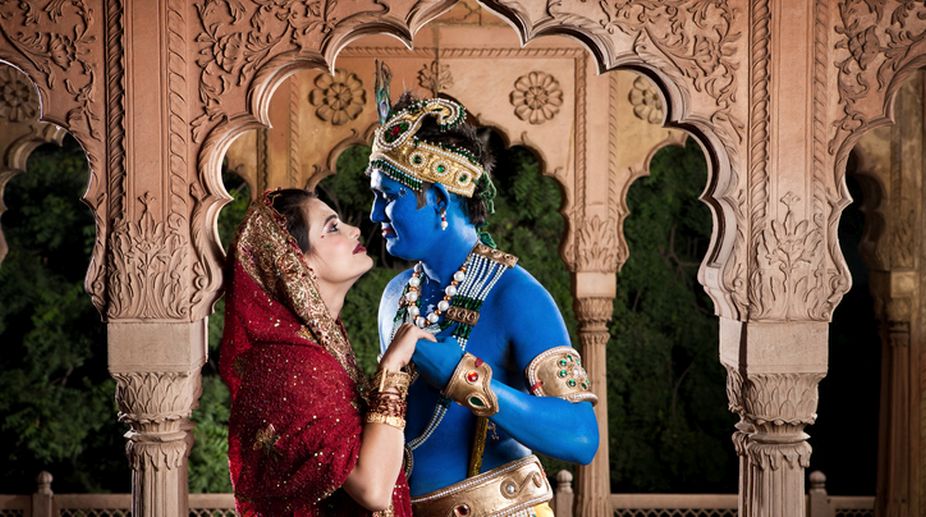Ballad of the Dark Lord is a lyrical interpretation in English, of the romantic ashtapadi, Geet Govindam written by the 12th century poet, Jaydev. It complemented the dedicated efforts of the English author Barbara Stoller Miller, who had spent several years in India, conducting research and finally publishing a sincere translation of Geet Govindam in English verse, enhancing the deep emotion of the original lyrics and frank eroticism, which led many Indian critics to interpret the love between Radha and Krishna as an allegory of the human soul’s love for God.
Ballad of the Dark Lord, conceptualised and choreographed by Monalisa Ghosh, was a dance ballet in Odissi and creative style — the music was composed by Subhankar Chatterjee while the attractive costumes were designed by Ghosh herself. In the dance dramas choreographed by her, Ghosh — trained by Guru Kelucharan Mohapatra — always tries her utmost to keep the costumes as close as possible to their mythological representations. While performing in dance- dramas under Mohapatra, she was dressed up as Bakasur with a mask. For the character of Putana and Sakhis of Krishna, a long flowing lehenga-like skirt was used. The character of Jatayu from the Ramayana was also made to wear a mask, to make the portrayal of the mythological character more realistic.

A dance drama involves all elements of nritta, nritya and natya and therefore aharya abhinaya (pertaining to the kind of costumes worn) is of utmost importance. A clear example is Guru Kelucharan Mohapatra’s composition of Sita Haran, where to bring out the character of the deer; a costume that resembled one was usually the norm.
Ghosh is of the firm belief that the romanticism and passion expressed in the text, demands a picturesque representation for which her aharya abhinaya assumes greater importance. Her conception was awarded with a production grant by the Union ministry of culture.
The scenes follow the poet’s structure, in parts, to accommodate with the time frame. All the songs were, therefore, not included. The first scene of The Dark Lord portrayed poet Jaydev engrossed in writing and Padmavati beside him with the narration in the words of Miller in the background score, exhibited through a small window on stage.
Accompanied by dhak, dhol and kartal a procession entered. A huge image of Lord Jagannath was carried by bearers surrounded by devotees with kartals, conch shells, panchapradip (lamp with five wicks) in sankirtan style accompanied by dhunuchi nritya. While the Shobhajatra or procession progressed, Sri Chaitanya and his followers entered with the song Srita kamalakucha mandala sung in group chorus. At the same instance on the backdrop of the stage, the sea and sun rise was projected with great dramatic effect. Significantly, the group led by Sri Chaitanya walked into the sea.
Thereafter, the ten incarnations of Lord Vishnu was depicted through the astapadi, Pralaya Payodhi Jale, with a powerful and devotional presentation by Raju, Subhojit, Tanusree and Saumi. The scene changed to one portraying a young Radha and Krishna. The little Krishna made to escape while a desperate Radha tried her best to get him. In the end, Krishna’s flute calmed down Radha. Their exit brought in the adult Krishna, which was enacted suitably by Jit Ghosh. The drama was enhanced with motifs of flowers of different hues and peacocks displaying the festival of colours.
The astapadi, Lalita Labanga Lata provided a colourful picture of Krishna playing Holi with the gopis and Radha. Ghosh in the role of Radha aptly emoted bhakti bhava leading the audience to feel the love and admiration of a devotee. The scene ended with a picturesque pose of Radha and Krishna.
In Geet Govindam, the poet gave special importance to the Sakhis who actually mentor Radha to be one with Krishna. The sakhis, Supriya, Tanusree, Afrina and Juthika entered the stage in a joyful mood but their companion Radha was a killjoy. She expressed her longing for Krishna through Jaydev’s immortal voice Kesi He Madanaudaram. The chorographical presentation exhibiting the emotional interaction between Radha and her friends was poignantly expressed. The Sakhi’s plea was best expressed in the astapadi, Dhira Sameere Yamuna teere vasati vane Banamali. The choreographer portrayed Krishna’s state of mind to Radha with humour.
Next up, Chandrabali, the voluptuous beauty in the words of the poet, allured Krishna to Kunjavan where they indulged in love dalliance. Yahi Madhava Yahi Kesava showed Radha’s displeasure. The piece ended dramatically, with Mahamilan or union to the accompaniment of mardala, manjira and other instruments. Pushpabrishti (showering of flowers) accompanied the crown of Krishna being brought on. A spectacular show came to an end with rasikas hankering for more












